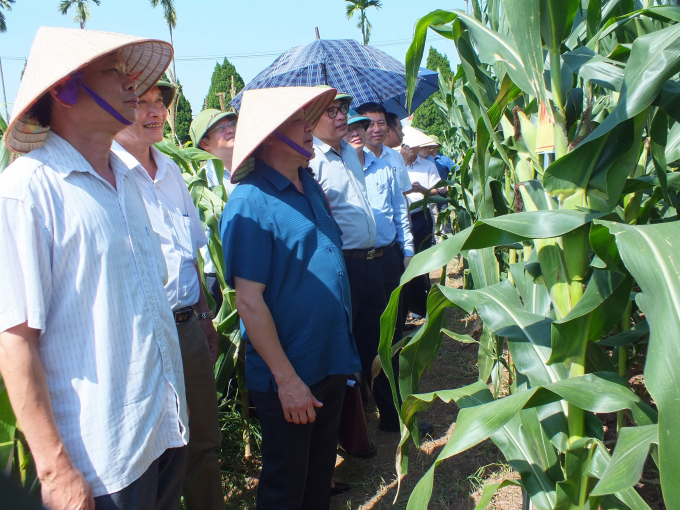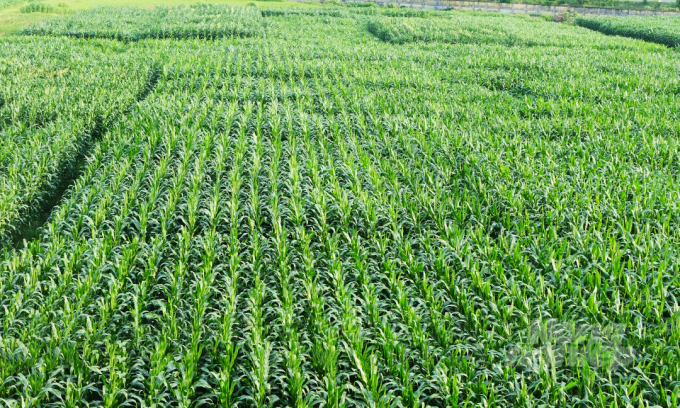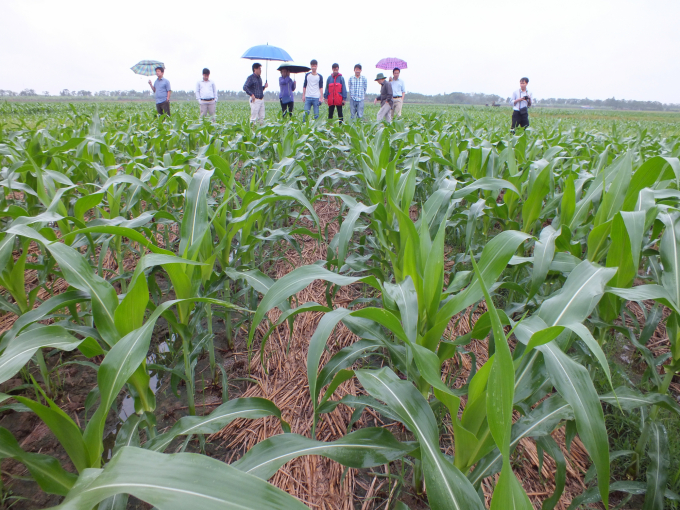June 19, 2025 | 10:32 GMT +7
June 19, 2025 | 10:32 GMT +7
Hotline: 0913.378.918
June 19, 2025 | 10:32 GMT +7
Hotline: 0913.378.918
Since early 2021, the costs of animal feeds have been steadily increasing, resulting in a rise in the prices of raw commodities such as corn. In many areas, farmers are torn between promoting corn stover production and sticking to plant corn varieties for seeds, owing to the approximately VND 40 million profit per ha/crop that corn stover generates.
At the moment, there are a few specialized corn stover feeding herbivorous cattle, although there are many corn varieties for seeds with a high potential for stover.

Deputy Minister of Agriculture and Rural Development Le Quoc Doanh (3rd from the left) visits some promising corn stover varieties of the Maize Research Institute. Photo: Le Ben.
Additionally, Dr. Nguyen Xuan Thang - Director of the Maize Research maize stover producers in many areas lack systematic data on the needs for specific corn varieties for stover corn production in animal husbandry.
Farmers choose corn varieties that produce seeds with a high biomass yield, as a result, disregarding other critical characteristics of biomass-specialized maize such as dry matter content, nutritional content, and palatability...
The Maize Research Institute focused on the following characteristics while choosing corn stover: brown leaf veins caused by mutant genes bm1 and bm3, which regulate enzymes involved in lignin synthesis; trait of many leaves, particularly the upper leaves of corn (the Leafy1 mutant gene is regulated), these varieties will have more leaf area, a shorter harvest time, and a longer seed accumulation period than other conventional corn varieties, thereby increasing nutrient efficiency.

The trial area to evaluate promising corn stover varieties of the Maize Research Institute. Photo: Bao Thang.
Additionally, high-protein corn variants (QPM) and multi-branched maize materials (Teosinte) are being investigated... Corn stover types must not only produce a lot of green material but also be of excellent quality.
The Institute confirmed that, in addition to variety, cultivation density and harvest time have a role in corn stover plantation. If the crop is harvested prematurely, the nutritional content will be depleted. On the other hand, a late harvest results in an inadequate yield. Therefore, in order to maximize production and efficiency, it is prudent to choose varieties that are tolerant of the soil and climatic conditions unique to each area.
“Historically, humans grew multipurpose corn types capable of both biomass production and seed production. However, these two objectives often conflict. For instance, whereas seed maize is critical for yield and grain quality, biomass maize is concerned with aspects such as stem growth, grain/corn ratio, and starch content "stressed Dr. Nguyen Xuan Thang.
Initially, the Maize Research Institute developed varieties for green food that are unique in comparison to maize for seeds. In the next years, the Institute will encourage research, reduce the cost of seeds, and reassure consumers about planting high-quality corn varieties, all of which will benefit the economy in the long run.

Currently, the land resources for winter crop in the North still abundant for corn stover production. Photo: Le Ben.
“The Ministry of Agriculture and Rural Development has a major initiative promoting corn stover. The Institute conducted research to identify a high-yielding cultivar with high stover yield and transfer potential for various locations throughout the country. To bolster corn stover growth, however, significant involvement from other divisions and departments is required.
While the current selling price of biomass corn ranges between VND 850 and 1,000 per kg, and the cost of long-distance transportation may increase by VND 100 to 200 per kg, if planning is inadequate, investors will question the investment's efficiency ", as expressed by the director of the Ngo Research Institute.
Dr. Nguyen Xuan Thang further evaluated that the Maize Research Institute and certain breeding units have addressed the first seed stage in the present development of maize stover, which is breeding selection, production organization, and output consumption.
In order for corn stover production to really become a commodity, it is essential to design a big enough production area that is sufficiently specialized in farming to allow for automation at the majority of phases of production. Additionally, raw material regions should be located near animal farms, near processing facilities, or in readily accessible and transportable places to save prices and expenditures.
Corn stover may be transformed into a full compound feed for grazing cattle in the future, establishing a contemporary and professional forage production and processing chain.
With these advancements, maize biomass may be seen as a critical component of the livestock industry's sustainable growth in the face of epidemics and unstable feed costs.
Translated by Linh Linh
![Turning wind and rain into action: [9] Digitizing hydrometeorological data in response to climate change](https://t.ex-cdn.com/nongnghiepmoitruong.vn/608w/files/news/2025/06/17/z6704423696987_15fd32ffc26d590d204d520c9dac6786-nongnghiep-165943.jpg)
(VAN) Farmers have begun accessing hydrometeorological applications to adjust their cropping schedules, aiming to ensure productivity and adapt to climate change.
![Turning wind and rain into action: [8] Real-time salinity detection and early warning technology](https://t.ex-cdn.com/nongnghiepmoitruong.vn/608w/files/news/2025/06/17/z6704423696987_15fd32ffc26d590d204d520c9dac6786-nongnghiep-151127.jpg)
(VAN) Thanks to the integration of modern hydrological-hydraulic models, remote sensing technologies, and artificial intelligence, the accuracy of hydrological forecasting has significantly improved.
![Turning wind and rain into action: [7] Early disaster warnings help marine farmers minimize losses](https://t.ex-cdn.com/nongnghiepmoitruong.vn/608w/files/news/2025/06/17/z6704423696987_15fd32ffc26d590d204d520c9dac6786-nongnghiep-142942.jpg)
(VAN) In recent years, thanks to early disaster warnings and forecasting, marine farmers in Khanh Hoa province have been able to reduce risks and losses, thereby improving production efficiency.
![Turning wind and rain into action: [6] ‘Four on-the-spot’ disaster management software](https://t.ex-cdn.com/nongnghiepmoitruong.vn/608w/files/news/2025/06/17/e5a48259d6a262fc3bb3-nongnghiep-183800.jpg)
(VAN) By simply activating the scenario on the disaster management software, the relevant authorities immediately know how many households need to be evacuated, where to evacuate them to, and by what means of transportation…
![Turning wind and rain into action: [5] Hue applies modern technology in disaster forecasting](https://t.ex-cdn.com/nongnghiepmoitruong.vn/608w/files/news/2025/06/17/z6704423696987_15fd32ffc26d590d204d520c9dac6786-nongnghiep-093938.jpg)
(VAN) In Hue city, modern technology has recently been applied in meteorological and hydrological forecasting and warning, helping to reduce the damage caused by natural disasters.

(VAN) A cutting-edge farming technique being implemented on an experimental ranch in Arizona's Sonoran Desert has already saved a billion gallons of water over five years, according to Civil Eats.

(VAN) Poultry and pig production and the environment can be boosted through enhanced water technology, according to new research.